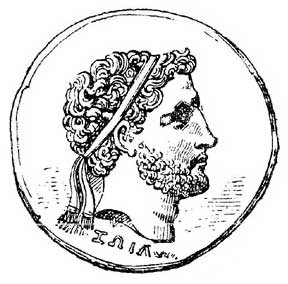|
|
, , , , , , , , , Example Aphrodite (Bartlett Head) Late Classical or Early Hellenistic Period about 330–300 BC : , , , Example of Statues: 460 BC The sakkoi and the mitra were, on the contrary, made of close materials. The sakkoi covered the head entirely like a sack or bag; it was made of various materials, such as silk, byssus, and wool (comp. Aristoph. Thesm. 257). Sometimes, at least among the Romans, a bladder was used to answer the same purpose (Mart. viii.33.19). The mitra was a broad band of rich cloth of different colours, which was wound round the hair, and was worn in various ways. It was originally an Eastern head-dress, and may, therefore, be compared to the modern turban. It is sometimes spoken of as characteristic of the Phrygians (Herod. i.195, vii.62; Virg. Aen. ix.616, 617; Juv. iii.66). It was, however, also worn by the Greeks, and Polygnotus is said to have been the first who painted Greek women with mitrae (Plin. H.N. xxxv.9 s35). William SmithFillet a narrow piece of fabric which was worn around the head, for decorative effect. ( Gossman/Lewis Greek Fashion Terms) Krobulos, a way of arranging the hair, a sort of topknot or crest formed by drawing all the hair to the crown and there confining it in a knot. This was old-fashioned for men in the time of Xenophon, but the hair was still worn so by children. Tiara: crown like headdress of jewels
Coin of Polos Sphendone On vases, however, we most frequently find the heads of females covered with a kind of band or a coif of net-work. Of these coiffures one was called sfendonh, which was a broad band across the forehead, sometimes made of metal, and sometimes of leather, adorned with gold William Smith
It was worn during the day as well as the night, and has continued in use from the most ancient times to the present day. It is mentioned by Homer (Il. xxii.469), and is still worn in Italy and Spain. These hair-nets were frequently made of gold-threads (Juv. ii.96; Petron. 67), sometimes of silk (Salmas. Exerc. ad Solin. p392), or the Elean byssus (Paus. vii.21 §7), and probably of other materials, which are not mentioned by ancient writers. The persons who made these nets were called kekrufaloplokoi (Pollux, vii.179). William Smith Hairnet Phrygian Bonnet One of the most replicated styles of hat worn by the Greeks. This style has come back into fashion frequently. It was shaped in a softly conical shape, rather like a stocking cap, with a peak falling forward and with side pieces hanging down. ( Gossman/Lewis Greek Fashion Terms). The Bonnet was worn by the insurgents during the French Revolution
 |
||||||||||||||||||


